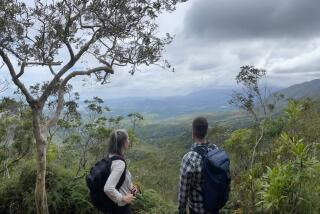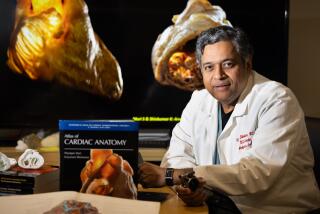French Develop ‘Map’ to Guide Genetic Searchers : Science: Genome blueprint will aid in fighting diseases. Similar U.S. project is at least two years from completion.
- Share via
Working in a warehouse-size laboratory filled with robot technicians, French researchers have made a significant advance in the race to identify the causes of all genetic diseases, acing out their American and Japanese competitors in the process.
The researchers report today in the British journal Nature that they have compiled the first “physical map” of the human genome, the complete blueprint for the construction of a human being.
Their achievement comes at least two years ahead of the projected date for the completion of such a map by the American Human Genome Project, a 15-year, $3-billion project with a long-term goal of identifying the exact order of each of the 3 billion chemicals that compose the human genetic complement.
The physical map is an ordered collection of about 33,000 DNA fragments that contain the entire genome. It does not show the location of individual genes, but provides a series of guideposts that help geneticists navigate their way through the genome in their search for the individual genes that cause disease.
Although the map shows the equivalent of the location of individual states and cities, the Human Genome Project’s ultimate goal is akin to identifying the location of every house in the United States.
“It’s an important step forward,” said molecular biologist Maynard Olson of the University of Washington. “It makes it much easier to do basic research on human biology.”
“It will be an enormous practical boost to gene-hunters,” added geneticist Francis Collins, director of the National Center for Human Genome Research in Bethesda, Md.
The French team, headed by molecular biologist Daniel Cohen, general manager of the Center for the Study of Human Polymorphisms (CEPH) in Paris, will make the information contained in the physical map available at no cost, beginning today, on the Internet, the computer network that connects researchers around the world. A condensed version of the map, totaling 300 to 600 pages, will be published by Nature early next year.
Today’s paper in Nature merely announces the availability of the map and describes some of the philosophy and techniques used in its construction. “By publishing a short account of their work as a letter to Nature . . . Dr. Cohen and his colleagues have signaled their determination to make the map immediately available to anyone who may be able to help them refine it, as well as anyone who may need it in their own research,” said John Maddox, editor of Nature.
Wide availability of the information will effectively preempt the controversial efforts of U.S. government researchers to patent it. Cohen said Wednesday that he felt it important to make the information available because it was “paid for by the French people,” whose contributions to annual telethons conducted by the French Muscular Dystrophy Assn. supported his research. In 10 years, CEPH has received more than $40 million from the association. “With the kind of money they have given us, we couldn’t afford to fail.”
The value of the physical map is that researchers can study families with an inherited disease to determine which DNA (deoxyribonucleic acid) fragment carries the defective gene responsible. Instead of having to search through the entire genome, researchers will be able to search through only a small area to find the actual gene.
The human genome consists of an estimated 100,000 genes. The blueprints for those genes are encoded in four separate chemicals, called bases, that are joined together to make separate genes in the same way that the meaning of a sentence is encoded in the sequencing of letters of the alphabet. In this case, however, the sentence is 3 billion letters long.
Researchers hope to eventually determine the exact order in which each base appears in that sentence, a process known as sequencing. To date, researchers have sequenced about 3,500 genes, which do not even make up 1% of the 3 billion bases. Sequencing all the bases is important because it will reveal not only the causes of all genetic diseases but also a great deal about the normal functioning of the body. Together, this “Holy Grail” of genetic information should enable researchers to develop new therapies to treat the diseases and new prophylactic measures to prevent their occurrence.
But the genome is far too long for researchers to simply start at one end and begin sequencing. It must be broken down into manageable chunks of DNA that can be easily manipulated.
Cohen’s group has produced chunks of DNA in a form that can be readily manipulated and reproduced for distribution to other researchers. More important, they have determined the order in which the chunks appear in the genome, so that researchers will know that a particular piece of DNA appears at a particular site.
Previously, researchers worked with chunks of 200,000 to 400,000 bases. Cohen has been able to put together much larger pieces, each containing about 1 million bases. “And that has made it much easier to put the jigsaw puzzle together,” according to Olson.
Cohen took great advantage of automation to produce the information used to assemble the puzzle. In a 4,000-square-yard laboratory south of Paris, Cohen has assembled 30 robots, each of which can do the work of 10 human technicians.
Researchers are still a long way from having a sequence of the entire genome, which would enable them to locate each of the 100,000 genes. “It will take another two to five years to have a high-resolution physical map,” which would be equivalent to having a map of neighborhoods within cities, Cohen said. “Sequencing of the whole genome will occur in 10 or 15 years. And I believe it will take another five years just to identify all the genes, because reading the genome doesn’t mean understanding it.”
Nonetheless, researchers believe the new physical map will accelerate the sequencing process. David L. Nelson of the Baylor College of Medicine Human Genome Center concluded, “This is a fantastic resource that is going to make all of our lives easier.”






